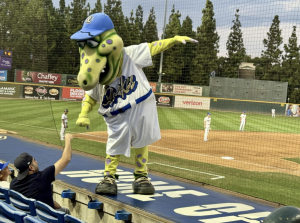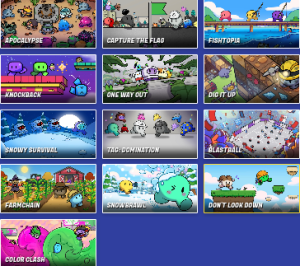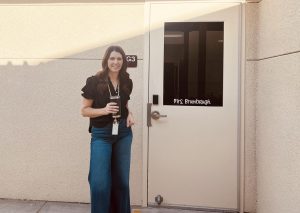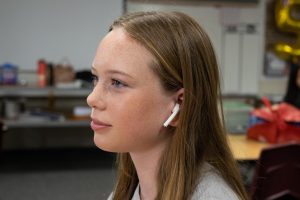Mariah’s Story
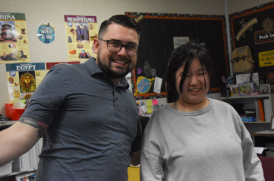
Mariah M. has formed very close connections to her teacher, Mr. Peek.
March 8, 2023
Many people wonder, “How does a special education student view school?” Although special education students are in different classes than the general ed. population, their school lives are not what you may think. From feeling left out, to having achievements they want to make in life, and having hobbies, special education students aren’t very different from general education students.
Mariah M. is a student in Mr. Peek’s special education class. She loves drawing, dancing, playing hide-and-seek, and watching TikTok.
While she may be in a different schooling program, her emotions aren’t that different from ours. Like everybody, Mariah gets upset.
“[When I’m sad, I talk to] this one,” Mariah said, pointing to one of the classroom aides, Ms. Heather.
Mariah is very close to her aides and teachers. In Mr. Peek’s class, there are multiple aides, including Ms. Heather, Ms. Tammy, and Ms. Melanie, that rotate between helping different students. They help her work through difficult times. Mr. Peek and Mr. Hensley also do their best to make their classrooms welcoming and comfortable for their students.
“Some of our friends have sensory needs, so they have some [problems] when it gets too loud or stuff like that, so they take walking breaks, and we’ll just do a quick lap around the buildings here, and then they’ll go back to class. It only takes about three to five minutes,” said Mr. Peek.
Going on walks is an example of how teachers accommodate students’ needs.
The halls aren’t the only place special education students can be seen. At Day Creek, special education students and their aides push into general education elective classes.
“I think one of the things that’s hardest to do in education [that] we’re always striving to continuously do better is to meet the needs of all students every day. It takes communication and really thinking about how to ensure that all students have work that they can complete and feel successful. As we learned at our credentialing program, the most important part of teaching is your preparation,” said Mrs. Porter, a seventh-grade teacher on campus.
Working with a spectrum of students can be challenging, but Day Creek’s teachers are constantly trying to improve their methods.
“[We do] a weekly email, so when I do my communication I [use the] communication [type] that [Mrs. Porter is using] so they’re getting a double-whammy; if they’re in both classes, they get communication from Mrs. Porter and myself,” said Mr. Rowland.
Parents of students who rotate into, for example, Mrs. Porter’s class from Mr. Rowland’s class will receive multiple emails about how their child is doing. But this does not necessarily mean that they are in trouble.
“[We talk about] a lot [of] things that are going well. A lot of the times I think kiddos and parents think that the only time we contact parents is when things aren’t going well. We strive to put in those ‘calm cookies.’ Some of it is [also] just your normal communication– if [students are] missing work, upcoming events on campus, [etc.], ” Mr. Rowland said.
Parents of special education students may get lots of messages from students, but most of it is just normal updates, “calm cookies” or what their child is succeeding in, and school news.
Special education students may also get different assignments than general education students, but, like communication, that is not usually bad.
“If you drive from here to Kansas, there’s a hundred different ways to get there. Everybody is going to go their own way. [It] just depends on the student and the path. There are some students that push in from my class [that] can do the same work as the peers around. Others might need different accommodations. They’re still learning the same standards; it’s just how they learn it [that may change],” said Mr. Rowland.
Even though special education students may get different assignments than their general education classmates, the goal is always the same: to meet the grade criteria.
“I think that’s the clearest misunderstanding I had of ‘differentiation.’ A lot of new teachers misinterpret ‘differentiation’ to mean a completely different assignment. At no point should anybody else be reading another book. The differentiation comes from what the process and product looks like as you’re accessing the curriculum,” said Mrs. Porter.
All curriculums are regulated by the district to make sure that students stay on grade level. But for the special education program in our district, teachers also work towards their students mastering what they don’t know, whether it’s more basic concepts or things that general education students on their grade level are learning.
According to MakingSchoolWork.com, “The goals of special education are similar to the educational goals for general education, but the techniques for attaining the goals are different. Children who have learning differences often require more intensive and individualized instruction and more repetition.”
“There’s always stuff that’s either modified or accommodated for any learner as needed. Sometimes we do strategies for a while to layer or accommodate for needs, and then, over time, that need changes, so that’s where the flexibility and planning comes in,” said Mrs. Porter.
It’s important for teachers to be able to motivate and excite their students to learn and grow in school, and Mariah’s teachers and aids do just that to help her in school, whether it’s from doing classwork to communicating her feelings.
“Miss Heather [inspires me to do my best, and] Mr. Peek and Mr. Hensley[‘s classes are my favorite] because my teachers do really good,” said Mariah.

